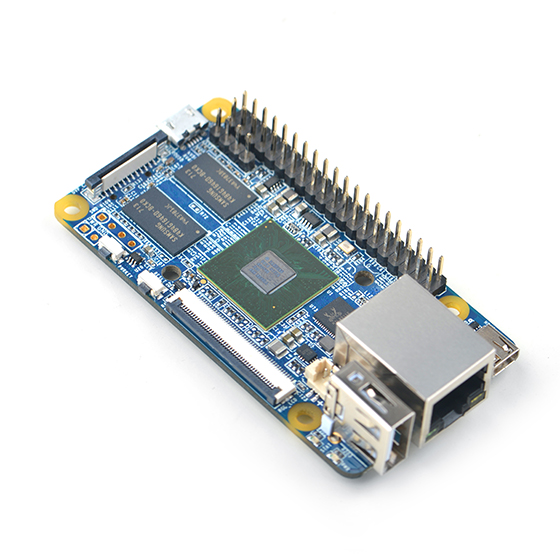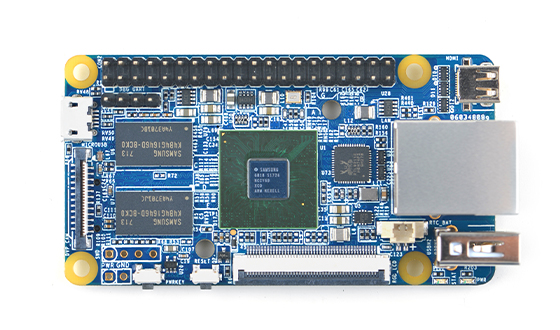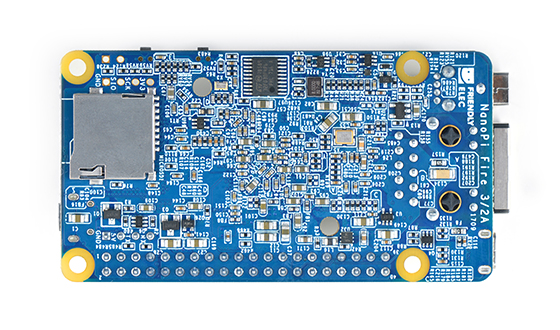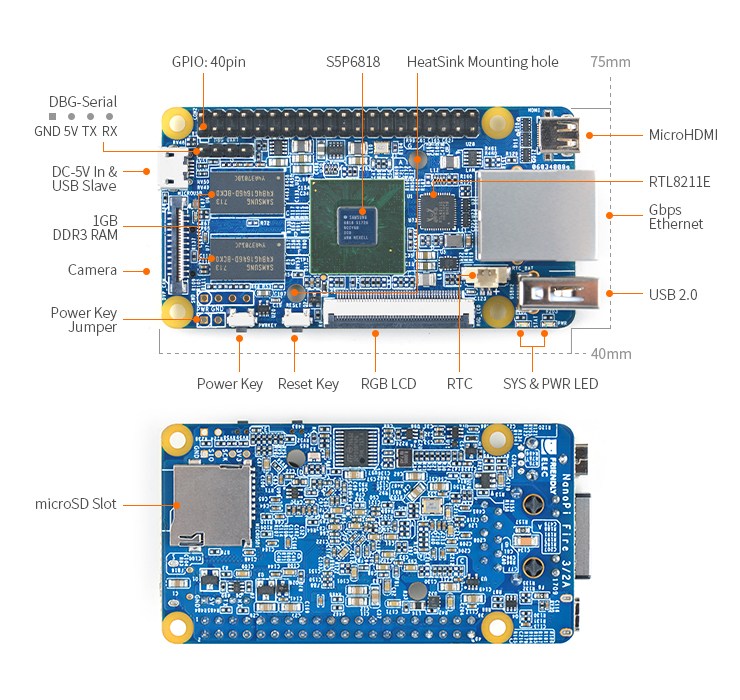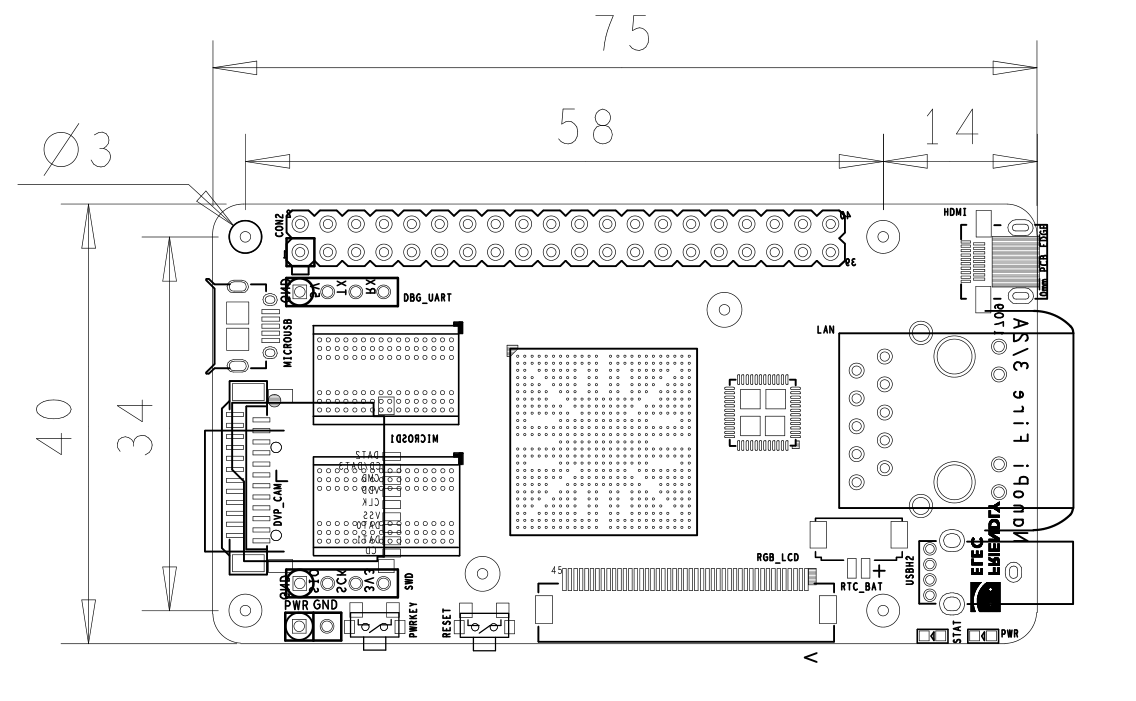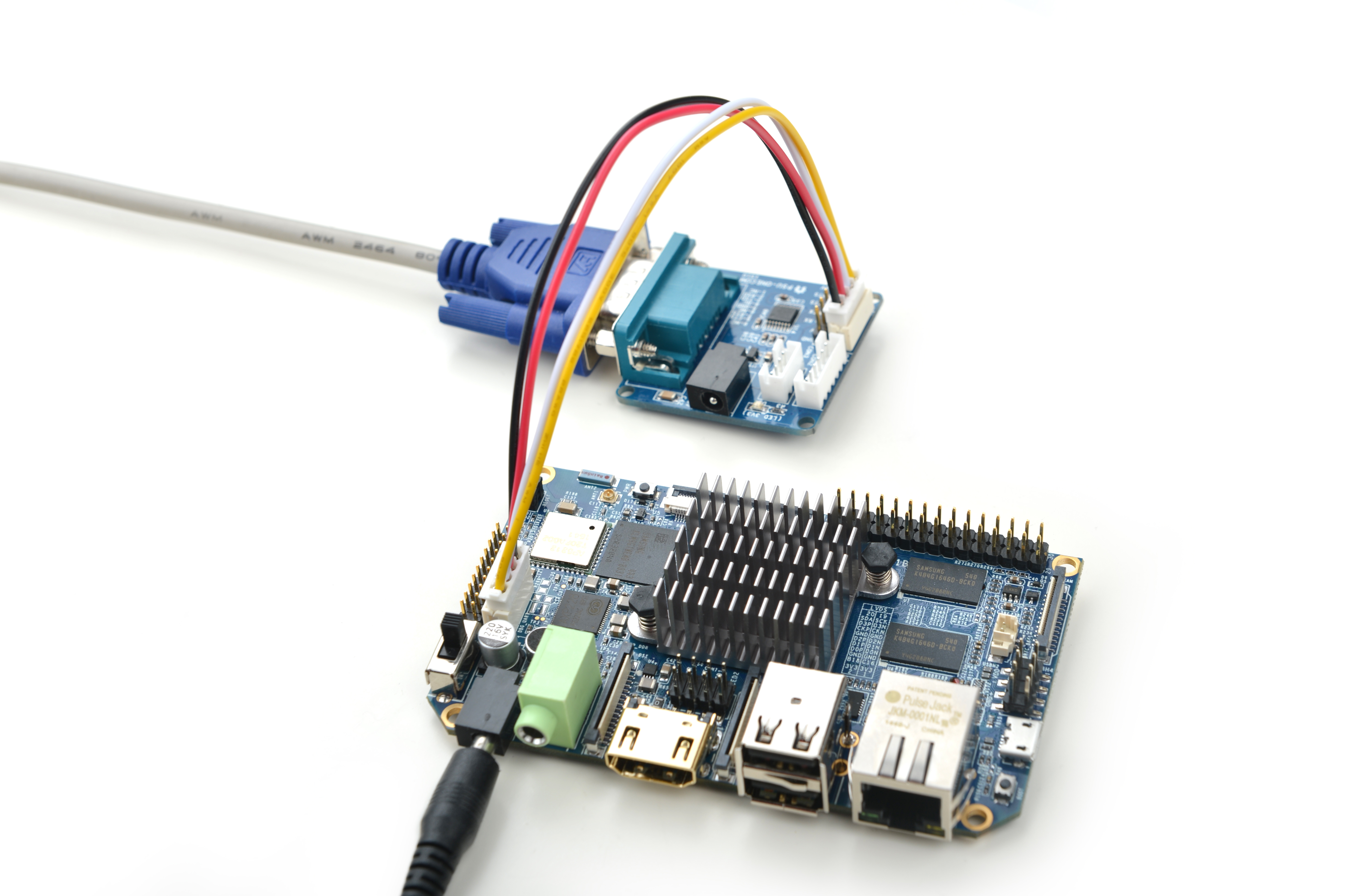NanoPi Fire3
Contents
- 1 Introduction
- 2 Hardware Spec
- 3 Software Features
- 4 Diagram, Layout and Dimension
- 5 Get Started
- 6 Working with Debian
- 7 Ubuntu-Core with Qt-Embedded
- 8 Make Your Own OS Image
- 9 Connect NanoPi Fire3 to External Modules
- 10 Android Hardware Access
- 11 Source Code and Image Files Download Links
- 12 Resources
- 13 Update Log
1 Introduction
- The NanoPi Fire3 is a high performance ARM Board developed by FriendlyElec for Hobbyists, Makers and Hackers for IOT projects. It features Samsung's Cortex-A53 Octa Core S5P6818@1.4GHz SoC and 1GB 32bit DDR3 RAM. It has a Gbps Ethernet port. It boots Android and Debian from a TF card. It integrates an HDMI and LCD interface. Its adoption of the Raspberry Pi's GPIO pin header makes it compatible with both Raspberry Pi's external GPIO modules and Arduino's shield boards. Its PCB dimension is 75 x 40 mm.
2 Hardware Spec
- CPU: S5P6818, 1.4GHz
- RAM: 1GBMB DDR3
- Connectivity: Gbps Ethernet port
- PMU Power Management: Implemented by a Cortex-M0 MCU, support software power-off, sleep and wakeup functions
- USB 2.0 Type A x 1
- Debug Serial Port/UART0 x 1
- microSD Slot x 1
- microUSB x 1: for data transmission and power input
- LCD Interface: 0.5 mm pitch SMT FPC seat, for full-color LCD (RGB: 8-8-8)
- HDMI: HDMI 1.4A, microHDMI(Type-D), 1080P60
- DVP Camera Interface: 0.5mm spacing FPC socket. It includes ITU-R BT 601/656 8-bit, I2C and IO
- GPIO: 2.54mm spacing 40pin, compatible with Raspberry Pi's GPIO. It includes UART, SPI, I2C, PWM, IO etc
- Button: Power Button x 1, Reset Button x 1
- LED: LED for Power Indication x 1, System LED x 1
- RTC: RTC Battery Seat
- PCB Dimension: 75 x 40mm
- Power: DC 5V/2A
- Temperature measuring range: -20℃ to 80℃
- OS: Android, Debian and FriendlyCore(Linux Kernel 4.4 + Qt5.9 + OpenGL2.0)
3 Software Features
3.1 FriendlyCore (Based on UbuntuCore16.04 with Qt5.9 and OpenGL ES1.1/2.0)
- Linux Kernel 4.4
- npi-config: npi-config: system configuration utility for setting passwords, language, timezone, hostname, SSH and auto-login
- networkmanager: manage network
- system log output from serial port
- welcome window with basic system information and status
- auto-login with user account "pi" with access to npi-config
- LibMali & OpenGL2.0 driver supported
- Qt5.9 TLS with OpenGL hardware acceleration
- HD video playing with hardware decoding
- GStreamer 1.0 with VPU hardware acceleration
- RPI.GPIO Support: work in progress, not ready yet
- WiringPi Support: work in progress, not ready yet
4 Diagram, Layout and Dimension
4.1 Layout
- GPIO Pin Spec
Pin# Name Pin# Name 1 SYS_3.3V 2 VDD_5V 3 I2C0_SDA 4 VDD_5V 5 I2C0_SCL 6 DGND 7 GPIOD8/PPM 8 UART3_TXD/GPIOD21 9 DGND 10 UART3_RXD/GPIOD17 11 UART4_TX/GPIOB29 12 GPIOD1/PWM0 13 GPIOB30 14 DGND 15 GPIOB31 16 GPIOC14/PWM2 17 SYS_3.3V 18 GPIOB27 19 SPI0_MOSI/GPIOC31 20 DGND 21 SPI0_MISO/GPIOD0 22 UART4_RX/GPIOB28 23 SPI0_CLK/GPIOC29 24 SPI0_CS/GPIOC30 25 DGND 26 GPIOB26 27 I2C1_SDA 28 I2C1_SCL 29 GPIOC8 30 DGND 31 GPIOC7 32 GPIOC28 33 GPIOC13/PWM1 34 DGND 35 SPI2_MISO/GPIOC11 36 SPI2_CS/GPIOC10 37 AliveGPIO3 38 SPI2_MOSI/GPIOC12 39 DGND 40 SPI2_CLK/GPIOC9
- Debug Port(UART0)
Pin# Name 1 DGND 2 VDD_5V 3 UART_TXD0 4 UART_RXD0
- DVP Camera Interface Pin Spec
Pin# Name 1, 2 SYS_3.3V 7,9,13,15,24 DGND 3 I2C0_SCL 4 I2C0_SDA 5 GPIOB14 6 GPIOB16 8 GPIOC13/PWM1 10 NC 11 VSYNC 12 HREF 14 PCLK 16-23 Data bit7-0
- RGB LCD Interface Pin Spec
Pin# Name Description 1, 2 VDD_5V 5V output, LCD power 11,20,29, 37,38,39,40, 45 DGND ground 3-10 Blue LSB to MSB RGB Blue 12-19 Green LSB to MSB RGB Green 21-28 Red LSB to MSB RGB Red 30 GPIOB25 available for users 31 GPIOC15 occupied by FriendlyARM one wire technology to recognize LCD models and control backlight and implement resistive touch, not applicable for users 32 XnRSTOUT Form CPU low when system is reset 33 VDEN signal the external LCD that data is valid on the data bus 34 VSYNC vertical synchronization 35 HSYNC horizontal synchronization 36 LCDCLK LCD clock, Pixel frequency 41 I2C2_SCL I2C2 clock signal, for capacitive touch's data transmission 42 I2C2_SDA I2C2 data signal, for capacitive touch's data transmission 43 GPIOC16 interrupt pin for capacitive touch, used with I2C2 44 NC not connected
- RTC
- 3.35uA@3V
- USB 2.0 Host
- with 1A over current protection
- Note
- SYS_3.3V: 3.3V power output
- VDD_5V: 5V power input/output. When the external device’s power is greater than the MicroUSB’s the external device is charging the board otherwise the board powers the external device. The input range is 4.7V ~ 5.5V
- For more details please refer to the schematic. NanoPi Fire3 1709 Schematic.pdf
4.2 Board Dimension
- For more details please refer to the dxf drawimg document.NanoPi Fire3 1709 dxf文件
5 Get Started
5.1 Essentials You Need
Before starting to use your NanoPi Fire3 get the following items ready
- NanoPi Fire3
- SD Card: Class 10 or Above, minimum 8GB SDHC
- A DC 5V/2A power is a must
- HDMI monitor or LCD
- USB keyboard, mouse and possible a USB hub(or a TTL to serial board)
- A host computer running Ubuntu 14.04 64 bit system
5.2 Make an Installation SD Card
5.2.1 Boot NanoPi Fire3 from SD Card
Get the following files from here to download necessary files:
- Get a 8G SDHC card and backup its data if necessary
Image Files: s5p6818-debian-sd4g-YYYYMMDD.img Debian image files s5p6818-android-sd4g-YYYYMMDD.img Android image files s5p6818-FriendlyCore-Xenial-4.4-YYYYMMDD.img Ubuntu Core + QT image files Flash Utility: win32diskimager.rar Windows utility. Under Linux users can use "dd"
- Uncompress these files. Insert an SD card(at least 8G) into a Windows PC and run the win32diskimager utility as administrator. On the utility's main window select your SD card's drive, the wanted image file and click on "write" to start flashing the SD card.
- Insert this card into your NanoPi Fire3's boot slot, press and hold the boot key and power on (with a 5V/2A power source). If the PWR LED is on and LED1 is blinking this indicates your NanoPi Fire3 has successfully booted.
5.2.2 Make Installation Card under Linux Desktop
- 1) Insert your SD card into a host computer running Ubuntu and check your SD card's device name
dmesg | tail
Search the messages output by "dmesg" for similar words like "sdc: sdc1 sdc2". If you can find them it means your SD card has been recognized as "/dev/sdc". Or you can check that by commanding "cat /proc/partitions"
- 2) Downlaod Linux script
git clone https://github.com/friendlyarm/sd-fuse_s5p6818.git cd sd-fuse_s5p6818
- 3) Make Android SD Card
su ./fusing.sh /dev/sdx
(Note: you need to replace "/dev/sdx" with the device name in your system)
When you run the script for the first time it will prompt you to download an image you have to hit “Y” within 10 seconds otherwise you will miss the download
- 4) Here is how to make a Debian SD card
./fusing.sh /dev/sdx debian
5.2.3 Extend NanoPi Fire3's SD Card Section
- When Debian/Ubuntu is loaded the SD card's section will be automatically extended.
- When Android is loaded you need to run the following commands on your host PC to extend your SD card's section:
sudo umount /dev/sdx? sudo parted /dev/sdx unit % resizepart 4 100 resizepart 7 100 unit MB print sudo resize2fs -f /dev/sdx7
(Note: you need to replace "/dev/sdx" with the device name in your system)
5.2.4 LCD/HDMI Resolution
When the system boots our uboot will check whether it is connected to an LCD or to an HDMI monitor. If it recognizes an LCD it will configure its resolution. Our uboot defaults to the HDMI 720P configuration.
If you want to modify the LCD resolution you can modify file "arch/arm/plat-s5p6818/nanopi3/lcds.c" in the kernel and recompile it.
If your NanoPi Fire3 is connected to an HDMI monitor and it runs Android it will automatically set the resolution to an appropriate HDMI mode by checking the "EDID". If your NanoPi Fire3 is connected to an HDMI monitor and it runs Debian by default it will set the resolution to the HDMI 720P configuration. If you want to modify the HDMI resolution to 1080P modify your kernel's configuration as explained above.
5.3 Update Image Files in SD Card From PC Host
If you want to make some changes to the image files in your SD card follow the steps below otherwise you can skip this section.
Insert your SD card into a host PC running Linux, mount the boot and rootfs sections of the SD card and follow the steps below:
1) If you want to change your kernel command line parameters you can do it via the fw_setevn utility under "sd-fuse_s5p6818/tools".
Check the current Command Line:
cd sd-fuse_s5p6818/tools ./fw_printenv /dev/sdc | grep bootargs
Android 5.1.1_r6 starts SELinux. By default it is enforcing. You can change it this way:
./fw_setenv /dev/sdc bootargs XXX androidboot.selinux=permissive
This sets it to "permissive". The "XXX" stands for the original bootargs' value.
2) Update Kernel
Our customized uboot will check the LCD type when it boots.
For Android it doesn't make any difference which display device is detected. You can use your generated uImage to replace the existing one under "boot".
For Debian if your generated kernel is for an LCD you need to replace the existing uImage or if your kernel is for an HDMI monitor you need to replace the existing uImage.hdmi.
5.4 Run Android or Debian
- Insert an SD card with Android/Debian image file into your NanoPi Fire3, connect the board to an HDMI monitor, press and hold the boot key, power on the board the NanoPi Fire3 will boot from the SD card. If you can see the PWR LED on and the LED1 flashing it means your board is working and you will see Android/Debain being loaded on the HDMI monitor.
1) If you connect the NanoPi Fire3 to an HDMI monitor you need to use a USB mouse and a USB keyboard to operate. If you connect it to an LCD with capacitive touch you can operate directly on the LCD.
2)If you want to do kernel development you need to use a serial communication board, ie a PSU-ONECOM board, which will allow you to operate the board via a serial terminal
- Here is a setup where we connect a NanoPi Fire3 to a PC running Ubuntu and Minicom via a serial cable you will see system messages output to the PC’s minicom terminal:
- Under Debian the password for "root" is "fa"
6 Working with Debian
6.1 Ethernet Connection
- If the NanoPi Fire3 is connected to a network via Ethernet before it is powered on, it will automatically obtain an IP after it is powered up.
6.2 Install Debian Packages
We provide a Debian Jessie image. You can install Jessie's packages by commanding "apt-get". If this is your first installation you need to update the package list by running the following command
apt-get updateYou can install your preferred packages. For example if you want to install an FTP server you can do this:
apt-get install vsftpdNote: you can change your download server by editting "/etc/apt/sources.list". You can get a complete server list from [1]. You need to select the one with "armhf".
7 Ubuntu-Core with Qt-Embedded
7.1 Introduction
Ubuntu Core with Qt-Embedded is a light Linux system without X-windows. It uses the Qt-Embedded's GUI and is popular in industrial and enterprise applications.
Besides the regular Ubuntu core's features our Ubuntu-Core has the following additional features:
- it supports our LCDs with both capacitive touch and resistive touch(S700, X710, S70)
- it supports WiFi
- it supports Ethernet
- it supports Bluetooth and has been installed with bluez utilities
- it supports audio playing
8 Make Your Own OS Image
8.1 Install Cross Compiler
Download the compiler package:
git clone https://github.com/friendlyarm/prebuilts.git sudo mkdir -p /opt/FriendlyARM/toolchain sudo tar xf prebuilts/gcc-x64/arm-cortexa9-linux-gnueabihf-4.9.3.tar.xz -C /opt/FriendlyARM/toolchain/
Then add the compiler's directory to "PATH" by appending the following lines in "~/.bashrc":
export PATH=/opt/FriendlyARM/toolchain/4.9.3/bin:$PATH export GCC_COLORS=auto
Execute "~/.bashrc" to make the changes take effect. Note that there is a space after the first ".":
. ~/.bashrcThis compiler is a 64-bit one therefore it cannot be run on a 32-bit Linux machine. After the compiler is installed you can verify it by running the following commands:
arm-linux-gcc -v Using built-in specs. COLLECT_GCC=arm-linux-gcc COLLECT_LTO_WRAPPER=/opt/FriendlyARM/toolchain/4.9.3/libexec/gcc/arm-cortexa9-linux-gnueabihf/4.9.3/lto-wrapper Target: arm-cortexa9-linux-gnueabihf Configured with: /work/toolchain/build/src/gcc-4.9.3/configure --build=x86_64-build_pc-linux-gnu --host=x86_64-build_pc-linux-gnu --target=arm-cortexa9-linux-gnueabihf --prefix=/opt/FriendlyARM/toolchain/4.9.3 --with-sysroot=/opt/FriendlyARM/toolchain/4.9.3/arm-cortexa9-linux-gnueabihf/sys-root --enable-languages=c,c++ --with-arch=armv7-a --with-tune=cortex-a9 --with-fpu=vfpv3 --with-float=hard ... Thread model: posix gcc version 4.9.3 (ctng-1.21.0-229g-FA)
8.2 Compile U-Boot
Download the U-Boot source code and compile it. Note that the github's branch is nanopi2-lollipop-mr1:
git clone https://github.com/friendlyarm/uboot_nanopi2.git cd uboot_nanopi2 git checkout nanopi2-lollipop-mr1 make s5p6818_nanopi3_config make CROSS_COMPILE=arm-linux-
After your compilation succeeds a u-boot.bin will be generated. If you want to test it flash it to your installation SD card via fastboot. Here is how you can do it:
1) On your host PC run "sudo apt-get install android-tools-fastboot" to install the fastboot utility;
2) Connect your NanoPi Fire3 to your host PC via a serial cable (e.g. PSU-ONECOME). Press the enter key within two seconds right after you power on your NanoPi Fire3 and you will enter uboot's command line mode;
3) After type in "fastboot" and press "enter" you will enter the fastboot mode;
4) Connect your NanoPi Fire3 to this host PC via a microUSB cable and type in the following command to flash u-boot.bin:
fastboot flash bootloader u-boot.bin
Warning: you cannot update this SD card by commanding "dd". This command will cause trouble when booting the NanoPi Fire3.
8.3 Prepare mkimage
You need the mkimage utility to compile a U-Boot source code package. Make sure this utility works well on your host before you start compiling a uImage.
You can install this utility by either commanding "sudo apt-get install u-boot-tools" or following the commands below:
cd uboot_nanopi2 make CROSS_COMPILE=arm-linux- tools sudo mkdir -p /usr/local/sbin && sudo cp -v tools/mkimage /usr/local/sbin
8.4 Compile Linux Kernel
8.4.1 Compile Kernel
- Download Kernel Source Code
git clone https://github.com/friendlyarm/linux-3.4.y.git cd linux-3.4.y git checkout nanopi2-lollipop-mr1
The NanoPC-T3's kernel source code lies in the "nanopi2-lollipop-mr1" branch.
- Compile Android Kernel
make nanopi3_android_defconfig touch .scmversion make uImage
- Compile Debian Kernel
make nanopi3_linux_defconfig touch .scmversion make uImage
After your compilation succeeds a uImage will be generated in the "arch/arm/boot/uImage" directory. This kernel is for LCD output. You can use it to replace the existing uImage.
If you want to generate a kernel for HDMI output you need to run nanopi3_linux_hdmi_defconfig and do it this way:
make nanopi3_linux_hdmi_defconfig touch .scmversion make menuconfig
After your compilation succeeds a uImage will be generated for HDMI 720P. If you want a uImage for 1080P you can do it this way:
touch .scmversion make nanopi3_linux_hdmi_defconfig make menuconfig Device Drivers --> Graphics support --> Nexell Graphics --> [ ] LCD [*] HDMI (0) Display In [0=Display 0, 1=Display 1] Resolution (1920 * 1080p) ---> make uImage
After your compilation succeeds a uImage will be generated for HDMI 1080P. You can use it to replace the existing uImage.hdmi.
- Compile Kernel for Ubuntu Core
The steps here are nearly the same as the steps for compiling a Debian kernel:
LCD Output:
make nanopi3_core-qt_defconfigHDMI Output:
make nanopi3_core-qt_hdmi_defconfigSelect your configuration file and run the following commands to generate a uImage.
touch .scmversion make uImage
8.4.2 Use Your Generated Kernel
- Update the kernel file in SD card
If you use an SD card to boot Android you can copy your generated uImage file to your SD card's boot section(e.g. section 1 /dev/sdX1).
If you use an SD card to Debian and you generated a uImage for an HDMI monitor you can use that uImage to replace the uImage.hdmi file in the SD card's boot section. If you use an SD card to Debian and you generated a uImage for an LCD you can use that uImage to replace the uImage file in the SD card's boot section.
- Update Android kernel file in eMMC
If you want to update the kernel file in eMMC you need firstly boot your board, then mount eMMC's boot section, replace the boot section's kernel file with your generated one and reboot your board to make your new kernel run.
If you boot your board from eMMC you can update your kernel file by following the steps below:
1) After Android is loaded mount eMMC's boot section (in our example eMMC's device name was /dev/mmcblk0p1) by using the following commands:
su mount -t ext4 /dev/block/mmcblk0p1 /mnt/media_rw/sdcard1/
2) Connect your board to a host PC running Ubuntu and copy the uImage file to eMMC's boot section by running the following commands;
adb push uImage /mnt/media_rw/sdcard1/
3) Or you can copy your generated kernel file to an external storage card(e.g. an SD card or a USB drive), connect the storage card to your board the move the file from the card to eMMC's boot section;
4) After update is done type in "reboot" to reload Android. Note don't directly power off and on the board or press the reset button to reboot the board. These two actions will damage your kernel file.
- Update Debian kernel file in eMMC
If you boot your board from eMMC you can update your kernel file by following the steps below:
1) When Debian is being loaded eMMC's boot section will be automatically mounted(in our example eMMC's device name was /dev/mmcblk0p1). You can use "mount" to verify that;
2) Connect your board to a host PC via Ethernet and copy your generated uImage file via scp/ftp to eMMC's boot section and replace the existing file. If your file is for an LCD use your uImage file to replace the existing uImage. If your file is for an HDMI monitor use your uImage.hdmi file to replace the existing uImage.hdmi file;
3) Or you can copy your generated kernel file to an external storage card(e.g. an SD card or a USB drive), connect the storage card to your board the move the file from the card to eMMC's boot section;
4) After update is done type in "reboot" to reload Debian. Note don't directly power off and on the board or press the reset button to reboot the board. These two actions will damage your kernel file
- Generate Your boot.img
If you want to generate an image file that can be flashed to eMMC you need to generate a boot.img file and copy it to your installation SD card.
For Android copy the uImage file to Android source code's "device/friendly-arm/nanopi3/boot/" directory and compile this whole Android source code. After your compilation is successful you will get a boot.img file.
For Debian follow the steps below to generate a boot.img file:
1) Download debian_nanopi2
git clone https://github.com/friendlyarm/debian_nanopi2.git
2) Copy the image file for an HDMI monitor and use it to replace the "debian_nanopi2/boot/uImage.hdmi" file and copy the image file for an LCD and use it to replace the "debian_nanopi2/boot/uImage" file;
3) Generate Debian's boot.img
cd debian_nanopi2 mkdir rootfs ./build.sh
A newly generated boot.img will be under the "debian_nanopi2/sd-fuse_nanopi2/debian" directory.
The "mkdir rootfs" command creates a working directory for the build.sh script to run. It also creates some files such as "rootfs.img" but these files are useless.
8.4.3 Compile Kernel Modules
Android contains kernel modules which are in the "/lib/modules" directory in the system section. If you want to add your own modules to the kernel or you changed your kernel configurations you need to recompile these new modules.
Compile Original Kernel Modules:
cd linux-3.4.y make CROSS_COMPILE=arm-linux- modules
Here we have two new modules and we can compile them by following the commands below:
cd /opt/FriendlyARM/s5p6818/android ./vendor/friendly-arm/build/common/build-modules.sh
The "/opt/FriendlyARM/s5p6818/android" directory points to the top directory of Android source code. You can get more details by specifying option "-h".
After your compilation succeeds new modules will be generated
8.5 Compile Android
- Install Cross Compiler
Install 64 bit Ubuntu 14.04 on your host PC.
sudo apt-get install bison g++-multilib git gperf libxml2-utils make python-networkx zip sudo apt-get install flex libncurses5-dev zlib1g-dev gawk minicom
For more details refer to https://source.android.com/source/initializing.html 。
- Download Source Code
You need to use repo to get the Android source code. Refer to https://source.android.com/source/downloading.html 。
mkdir android && cd android repo init -u https://github.com/friendlyarm/android_manifest.git -b nanopi3-lollipop-mr1 repo sync
The "android" directory is the working directory.
- Compile System Package
source build/envsetup.sh lunch aosp_nanopi3-userdebug make -j8
After your compilation succeeds an image will be generated in the "out/target/product/nanopi3/" directory.
filename partition Description boot.img boot - cache.img cache - userdata.img userdata - system.img system - partmap.txt - partition file
- Flash Image to SD Card
If you want to boot your board from an SD card you need to copy your generated image file to the "sd-fuse_s5p6818 /android/" directory and flash it to your SD card with our script. For more details refer to # Make an Installation SD Card under Linux Desktop。
9 Connect NanoPi Fire3 to External Modules
9.1 Connect NanoPi Fire3 to USB Camera(FA-CAM202)
- In this use case the NanoPi Fire3 runs Debian. If you connect your NanoPi Fire3 to our LCD or an HDMI monitor after Debain is fully loaded click on "other"-->"xawtv" on the left bottom of the GUI and the USB Camera application will be started. After enter "welcome to xawtv!" click on "OK" to start exploring.
9.2 Connect NanoPi Fire3 to CMOS 5M-Pixel Camera
For more details about the CAM500A camera refer to [2]
- If your NanoPi Fire3 runs Android5.1 and it is connected to our LCD or an HDMI monitor after Android is fully loaded click on the "Camera" icon and the application will be started. You can take pictures or record videos
- Under Debian/Ubuntu a camera utility "nanocams" is available for previewing 40 frames and picture taking. You can try it by following the commands below
sudo nanocams -p 1 -n 40 -c 4 -o IMG001.jpg
For more details about the usage of the nanocams run "nanocams -h". You can get its source code from our git hub:
git clone https://github.com/friendlyarm/nexell_linux_platform.git
9.3 Use OpenCV to Access USB Camera
- The full name of "OpenCV" is Open Source Computer Vision Library and it is a cross platform vision library.
- When the NanoPi Fire3 runs Debian users can use OpenCV APIs to access a USB Camera device.
1. Here is a guideline on how to use OpenCV with C++ on the NanoPi Fire3:
- Firstly you need to make sure your NanoPi Fire3 is connected to the internet.Login to your NanoPi Fire3 via a serial terminal or SSH. After login type in your username(root) and password(fa):
- Run the following commands:
apt-get update apt-get install libcv-dev libopencv-dev
2. Make sure your USB camera works with the NanoPi Fire3. You can test your camera with NanoPi Fire3's camera utility.
3. Check your camera device:
ls /dev/video*
- Note:in our test case video0 was the device name.
4. OpenCV's code sample(official code in C++) is under /home/fa/Documents/opencv-demo. Compile the code sample with the following commands:
cd /home/fa/Documents/opencv-demo make
After it is compiled successfully a "demo" executable will be generated
5. Connect NanoPi Fire3 to USB Keyboard & Run the Following Command:
./demoopencv is successfully started
9.4 Connect NanoPi Fire3 to Matrix GPS Module
- The Matrix-GPS module is a small GPS module with high performance. It can be used in navigation devices, four-axle drones and etc.
- The Matrix-GPS module uses serial communication. When the NanoPi Fire3 is connected to the Matrix GPS module, after the NanoPi Fire3 is powered up type in the following command in a terminal or click on the xgps icon it will be started.
$su - fa -c "DISPLAY=:0 xgps 127.0.0.1:9999"
- Or on the Debian GUI start the LXTerminal, type in "xgps" and enter it will be started too.
For more details about this GPS module refer to Click to check
Refer to the following diagram to connect the NanoPi Fire3 to the Matrix-GPS:
Connection Details:
| Matrix-GPS | NanoPi Fire3 |
| RXD | Pin11 |
| TXD | Pin12 |
| 5V | Pin29 |
| GND | Pin30 |
9.5 Connect NanoPi Fire3 to FriendlyARM LCD Modules
- Android
Here are the LCDs that are supported under Android:S430, S700/S701, S702, HD700, HD702, HD101 and X710 all of which are LCDs with capacitive touch.
- Debian
Here are the LCDs that are supported under Debian:S430, S700/S701, S702, HD700, HD702, HD101 and X710 all of which are LCDs with capacitive touch;
W35B, H43, P43, S70D and Matrix 2.8" SPI Key TFT LCD all of which are LCDs with resistive touch
All these LCD's tech details can be obtained on our wiki site:LCDModules
10 Android Hardware Access
FriendlyElec developed a library called “libfriendlyarm-hardware.so”, for android developer to access the hardware resources on the development board in their android apps, the library is based on Android NDK.
Accessible Modules:
- Serial Port
- PWM
- EEPROM
- ADC
- LED
- LCD 1602 (I2C)
- OLED (SPI)
Accessible Ports:
- GPIO
- Serial Port
- I2C
- SPI
Please refer to the following url for details:
- Homepage: http://wiki.friendlyarm.com/wiki/index.php/Android_Hardware_Access
- Examples: https://github.com/friendlyarm/AndroidHardwareAccess
- Guide to API in Chinese: https://github.com/friendlyarm/AndroidHardwareAccess/blob/master/友善电子Android硬件开发指南.pdf
11 Source Code and Image Files Download Links
12 Resources
12.1 User's Manual, Datasheet & Schematics
- SOC Datasheet: S5P6818 Datasheet
- AXP228_Users_Manual AXP228_V1.1_20130106
- eMMC eMMC5.0_1xnm_based_e_MMC
- Schematic: NanoPC-T3 Schematic
- PCB Dimension: NanoPC-T3-Dimensions(dxf)
13 Update Log
13.1 Nov-21-2017
- Released English version
